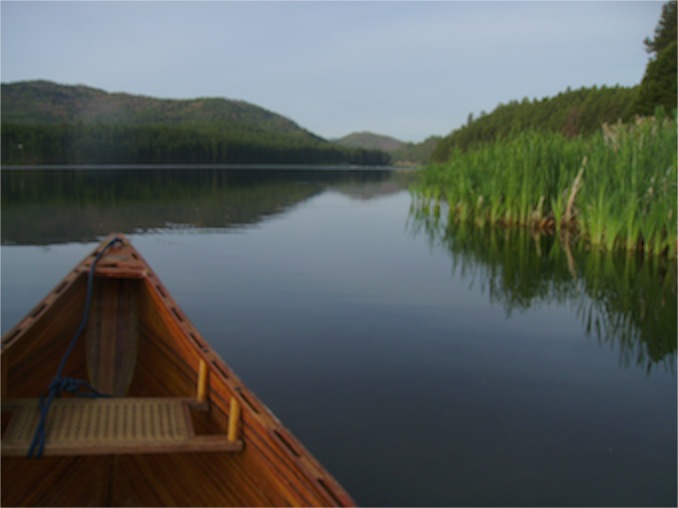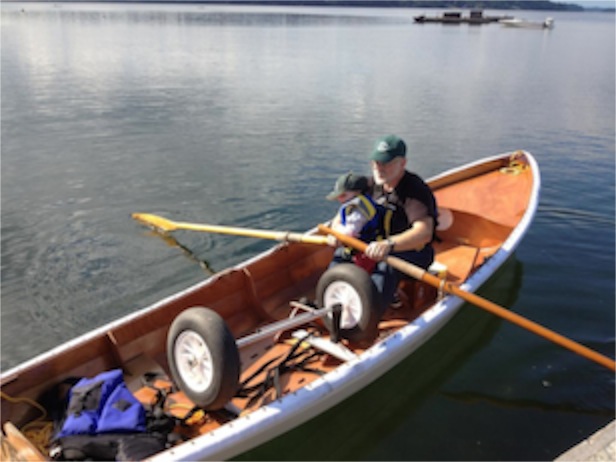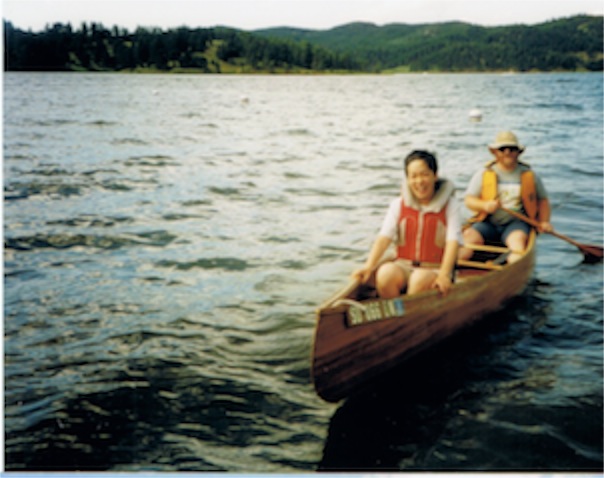The perfect boat
30/07/13 05:31
I recently read an article in a magazine that I receive about a man who has found the perfect canoe. He gives the history of his various canoe purchases and speaks of the problems that he found with various canoes. But now he believes that he is the owner of the perfect canoe. The canoe he claims is perfect is a 15’ Fletcher’s Fancy.
 Now I have to admit that he does own a really nice canoe. Thelma Cameron built that canoe. She makes canoes the old fashioned way, one at a time. She does use forms that assure that here canoes are consistent in shape and size, but each has hand-steamed and bent ribs, hand shaped cedar planking and canvas carefully stretched to cover the canoe. The Fletcher name comes from her uncle Paul Fletcher, who was an aircraft designer, but obviously knew a thing or two about boats as well. In many respects they reflect the shape and style of Chestnut canoes. Each of Thelma’s canoes is a work of art. They are beautiful, lightweight and very functional.
Now I have to admit that he does own a really nice canoe. Thelma Cameron built that canoe. She makes canoes the old fashioned way, one at a time. She does use forms that assure that here canoes are consistent in shape and size, but each has hand-steamed and bent ribs, hand shaped cedar planking and canvas carefully stretched to cover the canoe. The Fletcher name comes from her uncle Paul Fletcher, who was an aircraft designer, but obviously knew a thing or two about boats as well. In many respects they reflect the shape and style of Chestnut canoes. Each of Thelma’s canoes is a work of art. They are beautiful, lightweight and very functional.
But I can’t accept the description of “perfect.” It may be the perfect canoe for the author of the article, but there are some drawbacks to any 15’ canoe. Though the boat will haul enough weight to be paddled tandem, it really works better as a solo canoe if one is carrying a lot of supplies. And fully loaded it is a bit short of freeboard for those really windy days that come up on northern lakes. The canoe wouldn’t handle much of a sail rig if it were to be sailed, though the author seems to have no intention of doing so. While the canoe may be perfect for the use that it gets and the owner that it has, no canoe is truly perfect for every situation and circumstance.
At any rate, I’m still looking for my “perfect” canoe. I have some boats that I really like. This summer I have been paddling a woodstrip canoe that I made in 2001 to the lines of a Chestnut Prospector. In many ways it is a similar shape of the canoe that was touted as perfect. It is a foot longer and is covered with fiberglass instead of canvas. It probably weighs about ten pounds more the way that I built it. Still, it is light enough for me to handle by myself, a joy to paddle solo and has plenty of room for a second paddler and all of the equipment that one would need for a multiple-day camping trip. It has enough rocker and freeboard to take waves, but still carves a remarkably straight line on a calm lake. It is beautiful and feels just right under paddle. It is symmetrical, which means that I can treat it as if either end is the bow, a nice feature for a multiple-use canoe. When paddling tandem, we head out with the bow in front. When paddling solo, I turn the boat around so that I can occasionally sit in the bow seat while facing the other direction. That puts my weight closer to the center of the boat. And it provides a relief from the sometimes-stiff knees when I have been kneeling for too long a time. I still prefer to paddle kneeling, but like the ability to change from time to time.
 It isn’t my only boat however. I suppose that the author who has found the perfect canoe can understand why I built a rowboat for adventures with my young grandson and why rowing is another excellent exercise for a rotund middle-aged man. And I suspect he can understand that a kayak works a bit better for whitewater and for expeditions along the shores of the ocean. Of course he would notice that my 17’ expedition kayak is really different from my little play boat that is used in creeks.
It isn’t my only boat however. I suppose that the author who has found the perfect canoe can understand why I built a rowboat for adventures with my young grandson and why rowing is another excellent exercise for a rotund middle-aged man. And I suspect he can understand that a kayak works a bit better for whitewater and for expeditions along the shores of the ocean. Of course he would notice that my 17’ expedition kayak is really different from my little play boat that is used in creeks.
But when it comes to just canoes, I can’t choose just one. For nostalgia and for just plain fun with a gang of people it is hard to beat my 1960 Old Town OTCA. It is a great wood and canvass boat that I restored a number of years ago. It is read and beautiful and easy to paddle. It is very difficult to swamp and a great beginner canoe for kids. We’ve had a lot of fun paddling it on lakes large and small. It was our primary tandem canoe for our Lake Superior adventure a few years ago. But it is heavy, and I already notice that I sometimes struggle to get it to the top of a car. I prefer to put it on one of the lower racks of the canoe trailer.
 I suppose that when I am too feeble to lift the bigger boats, I will still treasure my little Wee Lassie. It is just 13’ long and a really fun solo canoe. It can be paddled with either a traditional paddle or a double paddle like a kayak. It floats in a very small amount of water. It was the first boat I built after moving to South Dakota and it is made of fence cedar so the wood has lots of character. And it is light enough to pick up with one hand. But it is no boat for stormy weather. And it doesn’t heel over very well. I can’t make it work for freestyle or Canadian style paddling very well.
I suppose that when I am too feeble to lift the bigger boats, I will still treasure my little Wee Lassie. It is just 13’ long and a really fun solo canoe. It can be paddled with either a traditional paddle or a double paddle like a kayak. It floats in a very small amount of water. It was the first boat I built after moving to South Dakota and it is made of fence cedar so the wood has lots of character. And it is light enough to pick up with one hand. But it is no boat for stormy weather. And it doesn’t heel over very well. I can’t make it work for freestyle or Canadian style paddling very well.
So I haven’t found the perfect canoe. I suspect that other family members wish I would. The fantasy of my having only one boat holds the promise of my needing less room to store so many boats. A family with two persons hardly needs a trailer that will haul eight boats. So I’m still looking as I paddle four different canoes and four different kayaks and occasionally rowing a small yawl. I keep dreaming of the next boat I’ll build. I’m thinking a tandem or triple kayak or perhaps a guide boat. Now that I’m a grandpa, boats need to have room for a grandson.
The good news is that I can’t afford a custom-made boat like the one that was discovered to be perfect for the writer of the article. The only practical way for me to get another boat is to make one myself. Some of us might just not be made for only one boat.

But I can’t accept the description of “perfect.” It may be the perfect canoe for the author of the article, but there are some drawbacks to any 15’ canoe. Though the boat will haul enough weight to be paddled tandem, it really works better as a solo canoe if one is carrying a lot of supplies. And fully loaded it is a bit short of freeboard for those really windy days that come up on northern lakes. The canoe wouldn’t handle much of a sail rig if it were to be sailed, though the author seems to have no intention of doing so. While the canoe may be perfect for the use that it gets and the owner that it has, no canoe is truly perfect for every situation and circumstance.
At any rate, I’m still looking for my “perfect” canoe. I have some boats that I really like. This summer I have been paddling a woodstrip canoe that I made in 2001 to the lines of a Chestnut Prospector. In many ways it is a similar shape of the canoe that was touted as perfect. It is a foot longer and is covered with fiberglass instead of canvas. It probably weighs about ten pounds more the way that I built it. Still, it is light enough for me to handle by myself, a joy to paddle solo and has plenty of room for a second paddler and all of the equipment that one would need for a multiple-day camping trip. It has enough rocker and freeboard to take waves, but still carves a remarkably straight line on a calm lake. It is beautiful and feels just right under paddle. It is symmetrical, which means that I can treat it as if either end is the bow, a nice feature for a multiple-use canoe. When paddling tandem, we head out with the bow in front. When paddling solo, I turn the boat around so that I can occasionally sit in the bow seat while facing the other direction. That puts my weight closer to the center of the boat. And it provides a relief from the sometimes-stiff knees when I have been kneeling for too long a time. I still prefer to paddle kneeling, but like the ability to change from time to time.

But when it comes to just canoes, I can’t choose just one. For nostalgia and for just plain fun with a gang of people it is hard to beat my 1960 Old Town OTCA. It is a great wood and canvass boat that I restored a number of years ago. It is read and beautiful and easy to paddle. It is very difficult to swamp and a great beginner canoe for kids. We’ve had a lot of fun paddling it on lakes large and small. It was our primary tandem canoe for our Lake Superior adventure a few years ago. But it is heavy, and I already notice that I sometimes struggle to get it to the top of a car. I prefer to put it on one of the lower racks of the canoe trailer.

So I haven’t found the perfect canoe. I suspect that other family members wish I would. The fantasy of my having only one boat holds the promise of my needing less room to store so many boats. A family with two persons hardly needs a trailer that will haul eight boats. So I’m still looking as I paddle four different canoes and four different kayaks and occasionally rowing a small yawl. I keep dreaming of the next boat I’ll build. I’m thinking a tandem or triple kayak or perhaps a guide boat. Now that I’m a grandpa, boats need to have room for a grandson.
The good news is that I can’t afford a custom-made boat like the one that was discovered to be perfect for the writer of the article. The only practical way for me to get another boat is to make one myself. Some of us might just not be made for only one boat.